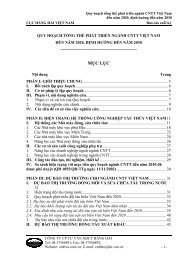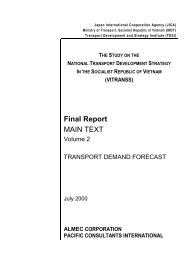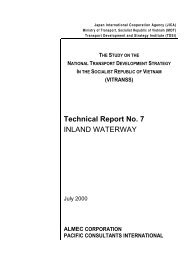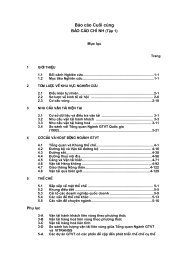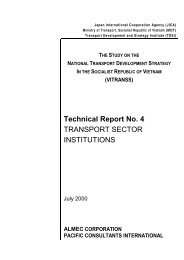Technical Report No. 8 PORT AND SHIPPING
Technical Report No. 8 PORT AND SHIPPING
Technical Report No. 8 PORT AND SHIPPING
You also want an ePaper? Increase the reach of your titles
YUMPU automatically turns print PDFs into web optimized ePapers that Google loves.
I-3-23<br />
Vietnam National Transport Strategy Study (VITRANSS)<br />
<strong>Technical</strong> <strong>Report</strong> <strong>No</strong>. 8<br />
Shipping and Ports<br />
The port of Hai Phong handles about 20% of total container transport in<br />
Vietnam. However, port equipment for cargo operation at this conventional<br />
port do not allow for a smooth container operation.<br />
In the central area of Hai Phong port, there are two berths available for<br />
container operation out of the total 14 berths. However, shore cranes can<br />
only carry five to 16 tons. At Chua Ve berth, which has a 300 m LOA and 7.0<br />
m depth, shore cranes can accommodate as much as 10 to 40 tons, making<br />
it more suitable for container operation.<br />
Given these port capacities, usual container operations are being handled<br />
mainly by the vessel’s cargo gears, which, however, result in inefficient<br />
operation and slow dispatch of vessels. Rehabilitation of cargo handling<br />
equipment is therefore a major issue not only for container operation but also<br />
for conventional cargo operation. One of the Vietnamese leading shipping<br />
companies with a registered homeport in Hai Phong, reported that in 1998<br />
alone the company suffered from demurrage (costs for extra stay) of 1,122<br />
days from the operation of their 21 general cargo vessels. This is mainly<br />
caused by waiting for high tide and their turn for cargo loading/unloading.<br />
Rehabilitation of port facilities and dredging of river channels are therefore<br />
other key aspects that need to be improved for better port and shipping<br />
operations.<br />
Operational Efficiency<br />
Vietnamese seagoing vessels and coastal shipping vessels are generally<br />
comprised of old (average of 21 years) and small-size vessels, except for some<br />
specialized cargo vessels. Major ports in Vietnam are still not well equipped with<br />
cargo-handling machines, such as gantry or shore crane on wharves, and some<br />
are too obsolete to be used.<br />
Thus, shipping vessels are often forced to operate cargo from berth or anchor<br />
using obsolete cargo gears for cargo loading and discharging, to and from<br />
wharves or floating barges alongside their ships. This system is neither efficient<br />
nor quick and prolongs the vessels’ stay at the port. The situation is different,<br />
however, at HCMC’s Tan Can Port which has a substantial number of containers.<br />
Here, cargoes are unloaded directly to barges and forwarded to the ICD. The<br />
problem though is that the ship’s responsibility for cargoes cover only up to their<br />
delivery to the ICD.<br />
Another problem affecting shipping operations is the insufficient water depth of<br />
the access channel to the main ports, particularly in the north. Vessels have to<br />
wait for high tide before they can approach or depart from the port, further<br />
decreasing the ship’s productivity. One of the leading state-owned shipping<br />
companies reported that in 1998, they suffered from demurrage at an average of



